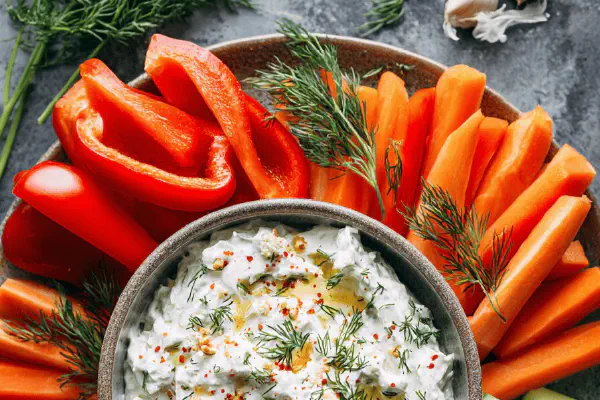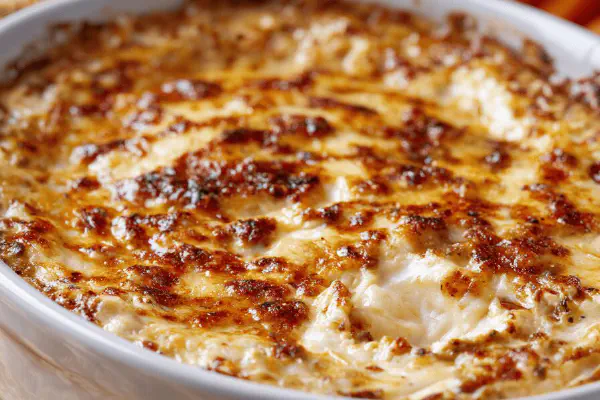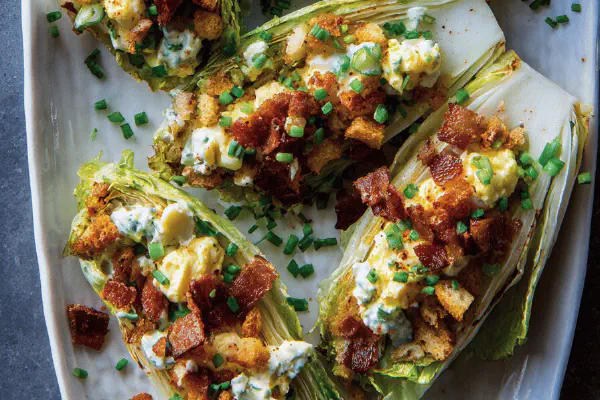Herb Goat Cheese Dip Crudités

By Emma
Certified Culinary Professional
Ingredients
Dip
- 80 g (3 oz) fresh goat cheese, softened
- 200 ml (3/4 cup) Greek yogurt 2 %
- 7 ml (1 1/2 tsp) maple syrup
- 20 ml (1 1/2 tbsp) chopped fresh dill
- 15 ml (1 tbsp) chopped fresh tarragon
- 15 ml (1 tbsp) Dijon mustard
- 3 ml (1/2 tsp) onion powder
- salt and black pepper to taste
Crudités
- 2 carrots, cut into sticks
- 1 celery root stalk, peeled and cut into sticks
- 1 red bell pepper, seeded and sliced
- 1/2 English cucumber, cut into sticks
About the ingredients
Method
Dip
- 1. Pulse goat cheese, yogurt, maple syrup in mini food processor or bowl using whisk attachment until creamy but still rustic. Don’t over-blend; want some texture to chew. Stir in dill, tarragon, Dijon, onion powder. Taste. Season with salt and crunchy black pepper. If too tangy, add tiny splash water to loosen.
Assemble
- 2. Spoon dip evenly into four wide-mouthed jars, around 1 1/2 cup measure. Smooth surface. Vertically tuck carrot, celery root, pepper and cucumber sticks into dip. They should stand erect like mini bouquets.
- 3. Seal jars tightly. Chill minimum 15 minutes to integrate flavors and firm dip just a bit. Serve cold or at room temp. Dip coats veggies; creaminess meets snap and earthiness from celery root sticks.
- 4. Store leftovers in fridge up to 2 days. If dip firms too much, let warm 10 minutes or stir in tiny splash yogurt or water to loosen.
Notes
- Swap celery root with classic celery only if you want crunch but expect less earthy depth. Dijon mustard replaces horseradish for subtler heat—adds tang without bite that overwhelms. Maple syrup instead of honey for different sweetness note, less floral, more caramel. Don’t skimp on herbs; dill and tarragon bring brightness and a hint of anise. Feel free to swap herbs depending on fresh availability.
- When cutting veggies, aim for uniform size so they fit well in jars and dip evenly. Razor-sharp knife prevents bruising; older carrots may be bitter, best choose fresh crisp ones.
- Avoid overmixing dip—overworked goat cheese separates. Light pulse or manual folding advised.
- Crunch and cream combo keeps snacks lively. A trick to keep celery root from browning: soak sticks briefly in cold water with lemon juice before assembling.
- Jars double as serving vessels—no extra mess. Wash and dry veggies thoroughly to avoid watering down dip.
- Experiment with herbs—chives or parsley could work if dill or tarragon unavailable. Experiment with seeded mustard for texture addition.
- Tactile cue: dip should hold shape but yield when poked with finger or spoon.
- Use small food processor blades for better control; blender may turn dip too watery.
- Visual cue: color changes slightly after mixing; herbs disperse evenly. Dip should be pale with green flecks.
- Serving tip: chilled dip thicker and more luxurious, room temp dip more spreadable. Depending on preference, adjust fridge time.
- Aroma is subtle herbaceous with sour cream and slight sweetness from syrup. Good sign if smell is fresh, not rancid or overly sour.
- If you can’t find goat cheese, tangy cream cheese can substitute but flavor shifts.
- If fridge time tight, prep dip up to 3 hours ahead then assemble with veggies last minute to keep crispness.
- Dipping sounds: soft scrape, gentle resistance when veggie bites into creamy base.
- Always use fresh herbs. Dried herbs dull flavor and alter moisture content.
- Cut vegetables on bias for visual appeal and crisp bite.
- Instead of cucumber sticks, try jicama or daikon for crunch variation.
- Make jars slightly bigger to accommodate large veggie sticks without crowding. Crowding causes veggies to sweat and lose snap.
- If dip looks lumpy, stir gently; lumps from goat cheese chunks are fine, add rustic texture.
- Do not stir dip vigorously after adding herbs—prevents bruising herbs and losing color.
- Add black pepper last, coarse grind preferred for textured bite.
- Try swapping bell pepper color for aesthetics—yellow or orange bring freshness.
- Store assembled jars upright to prevent dip settling and veggies falling.
- Use airtight containers with silicone seals; prevents fridge odors leaching in.
- After tasting, if dip too tart or sharp, tiny pinch sugar or more syrup smooths edges.
- For smoother dip, strain yogurt before mixing to remove excess whey.
- If blues from oxidation on herbs start to show, blitz quickly once more or add herbs at end.
- Try sprinkling freshly chopped herbs on top of dip before sealing for visual punch.
- To make vegan, swap goat cheese for soft tofu or vegan cream cheese; adjust seasonings carefully.
- When stirring, use silicone spatula to scrape sides and fold gently to preserve texture.
- The sweet note from syrup is the thread tying tart yogurt and tangy Dijon.
- You’ll find celery root adds a fascinating hint of earthiness missing from usual celery. Try it; once tried, no going back.
- Keep dip firm but spreadable; if unexpectedly runny, it means overwhipped or watery yogurt—use thicker Greek or strain source.
- For make-ahead snacks, store veggies separately in cold water; assemble last minute to retain snap.
- Serve pots chilled but not icy; numb taste buds kills the experience.
- If Dijon mustard is strong, reduce amount slightly and balance with extra herbs or syrup.
- Feel free to swap raw veggies to what’s freshest or preferred: cauliflower, snap peas, cherry tomatoes work too but modify chopping.
- A tiny bit of lemon zest adds brightness if you want to experiment.
- Onion powder avoids raw onion bite but adds umami depth; no substituting with fresh onion or smell dominates.
- No oil in this dip; adding can weigh it down and lose fresh texture.
- Use medium heat tools; low and slow blending best to maintain creaminess.
- Tasting between additions avoids overpowering with mustard or herbs.
- Don’t overfill jars; leave small air gap prevents pressure build-up when sealed.
- Prioritize freshness. Old goat cheese gets bitter. Sour yogurt obvious by smell and taste.
- Cut veggies just before serving or assembly to avoid dryness or moisture release. Keep refrigerated till last minute.
- If dip separates after a night, stir gently to reincorporate. No harm done.
- Crunch against creamy, tangy dip aligns with ideal textural contrast—listen to the bite.
- Use ceramic or stainless steel bowls for mixing to avoid off-flavors.
- Rustic texture preferred; not a mousse. Too whipped kills substance.
- Chop herbs fine but not paste; bits should remain visible inside dip.
- Maple syrup texture helps bind dip; honey or agave can stand in but changes final flavor.
- Plan on 5 minutes extra if you adjust ingredient quantities or mix by hand.
- Visual: dip looks fresh, glossy; herbs vivid; veggies bright and firm.
- These jars are conversation starters. No presentation fuss; fuss is flavorless.
Cooking tips
Chef's notes
- 💡 Pulse goat cheese and yogurt lightly—too much blending turns base watery. Want texture not mousse. Stir herbs gently after base blends; folding preserves fresh color. Salt and pepper last; coarse black pepper preferred for crunch in flavor.
- 💡 Use celery root for earthier crunch; peel fully with firm, sharp knife. Soak sticks briefly in cold lemon water to keep color and crisp. Don’t confuse celery root with classic celery; different mouthfeel and flavor punch, no subtlety.
- 💡 Chill dip only enough to firm; 15-20 minutes max or veggies lose snap. Ideal jar fill leaves small air gap on top. Seal tight to avoid fridge odors leaching in. Store in silicone-sealed airtight jars. Avoid overfilling or dip leaking on seal.
- 💡 Maple syrup over honey changes profile; less floral, more caramel undertones. If no goat cheese, tangy cream cheese works but expect shift in tang and texture. Dijon mustard replaces horseradish—milder heat, umami focus. Swap herbs if fresh dill or tarragon missing; chives or parsley suggested.
- 💡 Cut veggies uniform size for better jar fit and consistent dip coverage. Razor-sharp knife avoids bruising carrots - bruised bits leak water and taste bitter. Keep veggies dry post wash; wet veggies water down dip texture. Assemble last minute when possible.
Common questions
How to keep celery root sticks fresh?
Soak just briefly in cold water with lemon juice. Not too long or soggy. Keeps color bright, snap intact. Peel before soaking. Works better than plain water. Store cold.
What if dip gets too thick after chilling?
Fold in splash of yogurt or water. Small amounts only. Stir gently to reincorporate. Overmixing risks separating goat cheese. Pulsing or manual fold best approach to loosen while keeping rustic feel.
Can I substitute other veggies for crudités?
Yes. Jicama or daikon adds crunch variation. Snap peas, cherry tomatoes also work but chop size adjustments needed. Watch for moisture content; watery veggies dilute dip faster. Pick firm, fresh for best snap.
How long can I store assembled jars?
Up to 2 days in fridge best for freshness. Seal tight, airtight jars prevent odor transfer. Veggies may soften slowly. If dip separates overnight, stir gently before serving. Assemble veggies last minute if possible.



